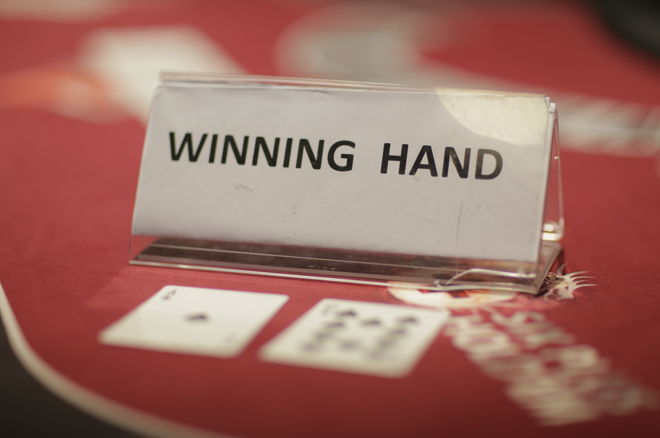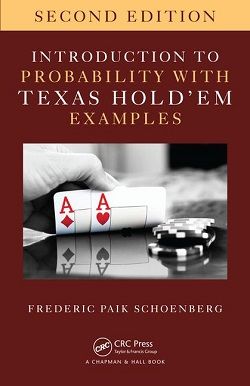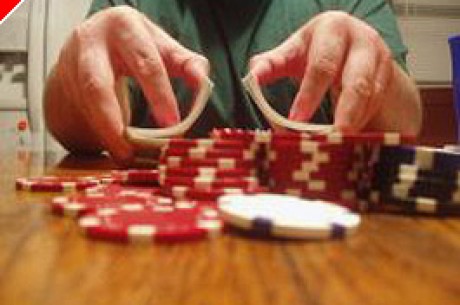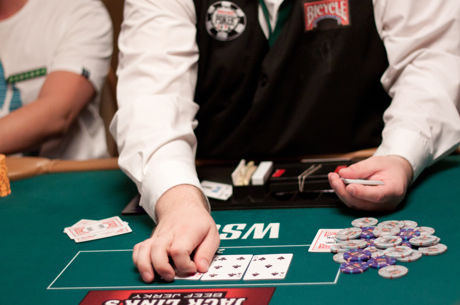Texas Hold'em Poker: A Tool for Teaching Statistics

As a college professor, I am always eager to bring poker examples into my classroom. Since I primarily teach probability and statistics courses, this tends to work well. I was thus very pleasantly surprised to come across a textbook titled, "Introduction to Probability with Texas Hold’em Examples". Written by Dr. Frederic Paik Schoenberg, Professor of Statistics at UCLA, this book is intended to be used in a college-level, calculus-based probability course, with every single example in the textbook drawing on the game of Texas Hold’em.
Review of the Textbook

Upon coming across this book, my first thought was, “Someone beat me to it.” But my next thought was, “Can this book actually be any good?” Despite the natural link between poker and probability, the majority of academic statisticians I have met are not really that into poker, with only a few exceptions coming to mind.
However, a quick scan of the book proved my skepticism to be wrong. Very wrong. Dr. Schoenberg’s wealth of examples using real hands from the World Series of Poker, High Stakes Poker, and other major events across the past couple of decades is truly impressive. Additionally, his depth and breadth of poker understanding is made apparent by his ability to place these hands in context and use them to ask meaningful questions from both a poker and a probabilistic standpoint. The usage of real data has been repeatedly championed as a cornerstone for best practices in statistics education, and while it is often easier said than done, Dr. Schoenberg has accomplished just that in a very impressive way throughout his book.
A Need for Real Examples
In Dr. Schoenberg’s own words, he writes in the preface to the book, “The first few times I taught probability, I was disappointed by many of the examples in the books. They typically involved socks in sock drawers or balls in urns. Most of my students did not even know what an urn was, and certainly were not motivated when informed of its meaning. I thought it would be interesting to try to teach the same topics as those covered in most probability texts using only examples from poker.”
So, this coming fall semester, I will be enthusiastically using this textbook as a required course text in my 300-level probability course.
Potential Bias
There are, however, a few concerns that have been brought up by some of my friends and colleagues. Firstly, there is a concern that using poker as a pedagogical platform may introduce a gender preference: that is, as much as we would like this not to be true, the current reality is that the average male tends to be more interested in poker than the average female, and probably more than most people who are anywhere else on the gender spectrum (though my anecdotal sample size is a bit smaller there). Second, the poker background that my students will come in with will likely be highly varied: some students may already be serious poker players, whereas others may have never even played Texas Hold’em before. To the extent that any of this might put any students at a disadvantage as far as their learning and/or their grade is concerned, I would definitely want to be cognizant of it.
Addressing the Concerns
To the first concern: I do not believe that there is an inherent Y-chromosomal predisposition to the enjoyment of poker. Rather, I believe that the imbalance that we currently see is largely due to societal gender norms; specifically, men have simply been exposed to poker at a much higher rate than women or any other gender. To a large degree, then, I believe that any gender preference induced by using poker in the classroom is, in essence, a specific case of a preference for those with more poker background to begin with. This is undoubtedly an oversimplification, but a deeper discussion is beyond the scope of this article.
Thus, assuming at least some level of accuracy to my above observation, I plan to simultaneously mitigate these concerns by beginning my class from the ground up as far as poker knowledge goes. We will begin on Day 1 by introducing everyone to the rules of Texas Hold’em, and I will aim to be very aware of any students who come in with little to no background in the game. Moreover, in line with a learn-by-doing philosophy that is integral to my teaching style in general, we will spend some class time that day actually playing the game.
I also plan to have a few poker nights for the class throughout the semester that will be “optional but highly recommended” (for free with the possibility of winning prizes that I will provide). Through this, my goal is to foster at least a modest level of curiosity and interest for the game among those who may not already have it, and enhance it among those who do, with the ultimate aim of fully utilizing the power of a fun game as a gateway towards the academic topics of probability that we will cover in the course.
Follow the Journey
Even among my most gambling-averse students or those who aren’t even into games in general, I believe that at the very least they will find Texas Hold’em to be more interesting than balls in urns. As is true on the first run of anything, though, I am sure that there will be bumps along the way, both anticipated and unforeseen. If you’d like to stay tuned to my experience, I plan to blog about it each week with an open comments section where I welcome any questions or feedback.
Peter Chi is an Assistant Professor of Statistics at Ursinus College, a small liberal arts college outside of Philadelphia, PA. While his professional interests lie mainly in biomedical research and evolutionary biology, he is an avid recreational poker player and enjoys using poker and other gambling examples in the classroom. Follow him on Twitter at @PeterBChi.









